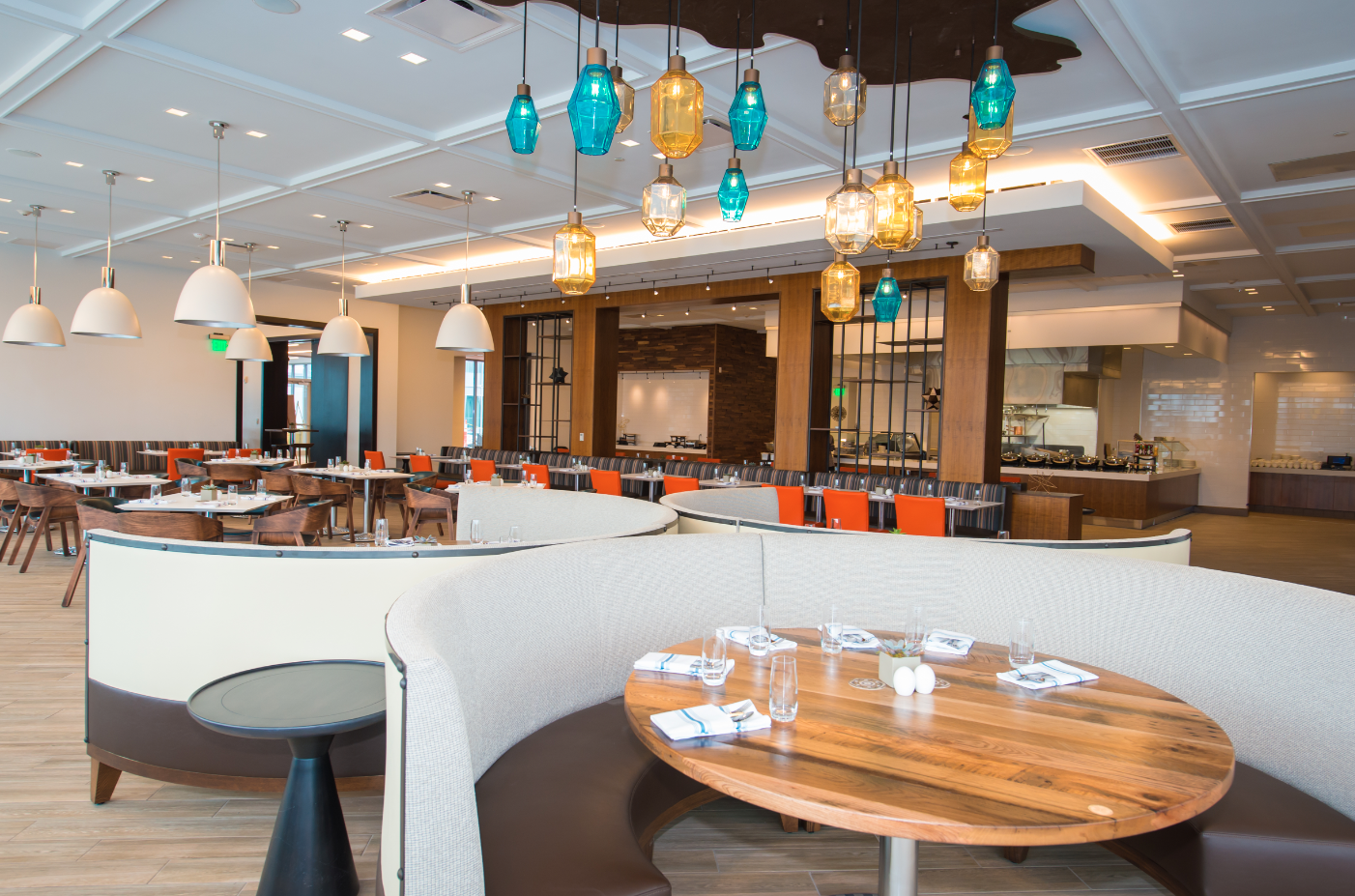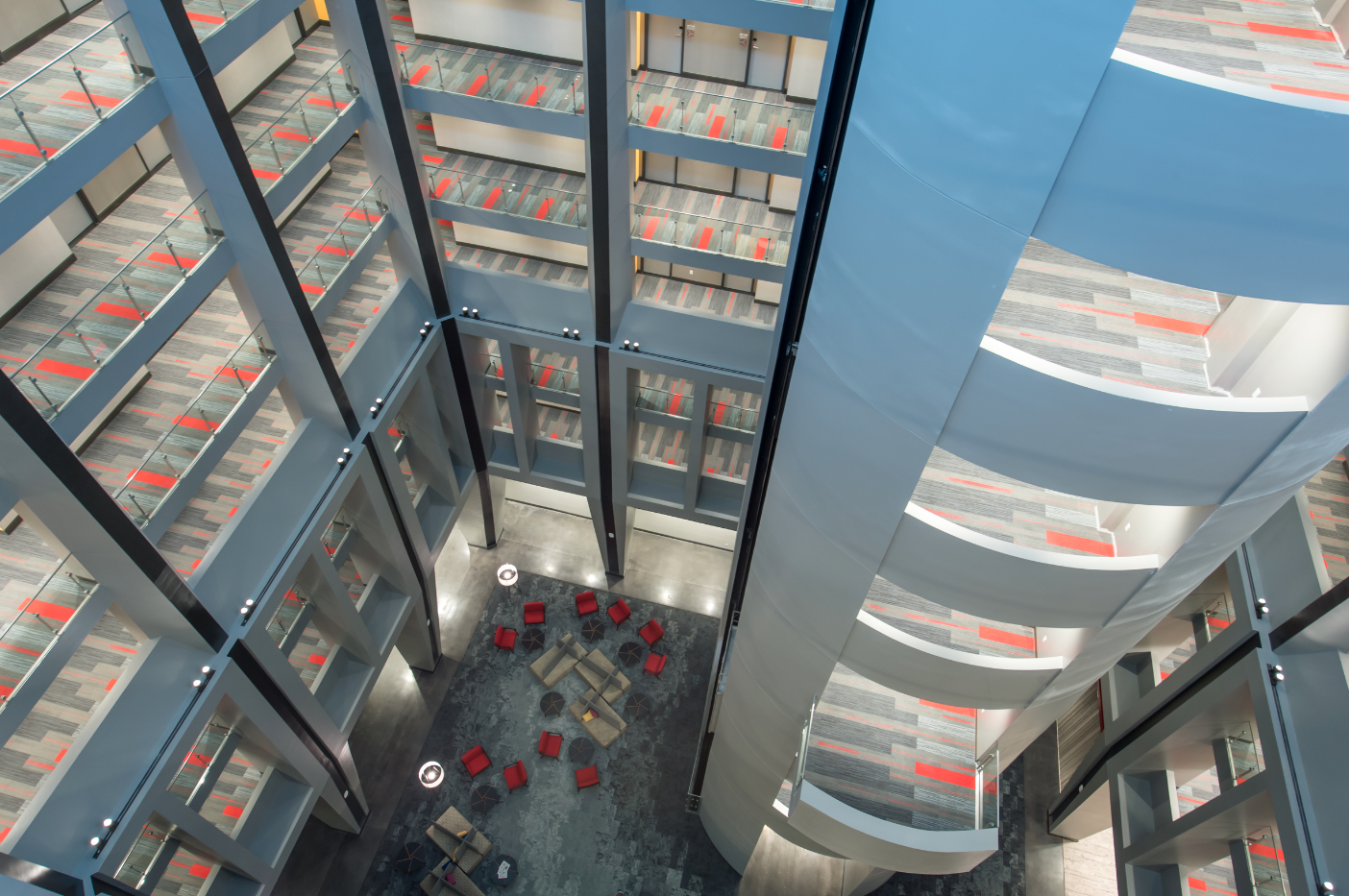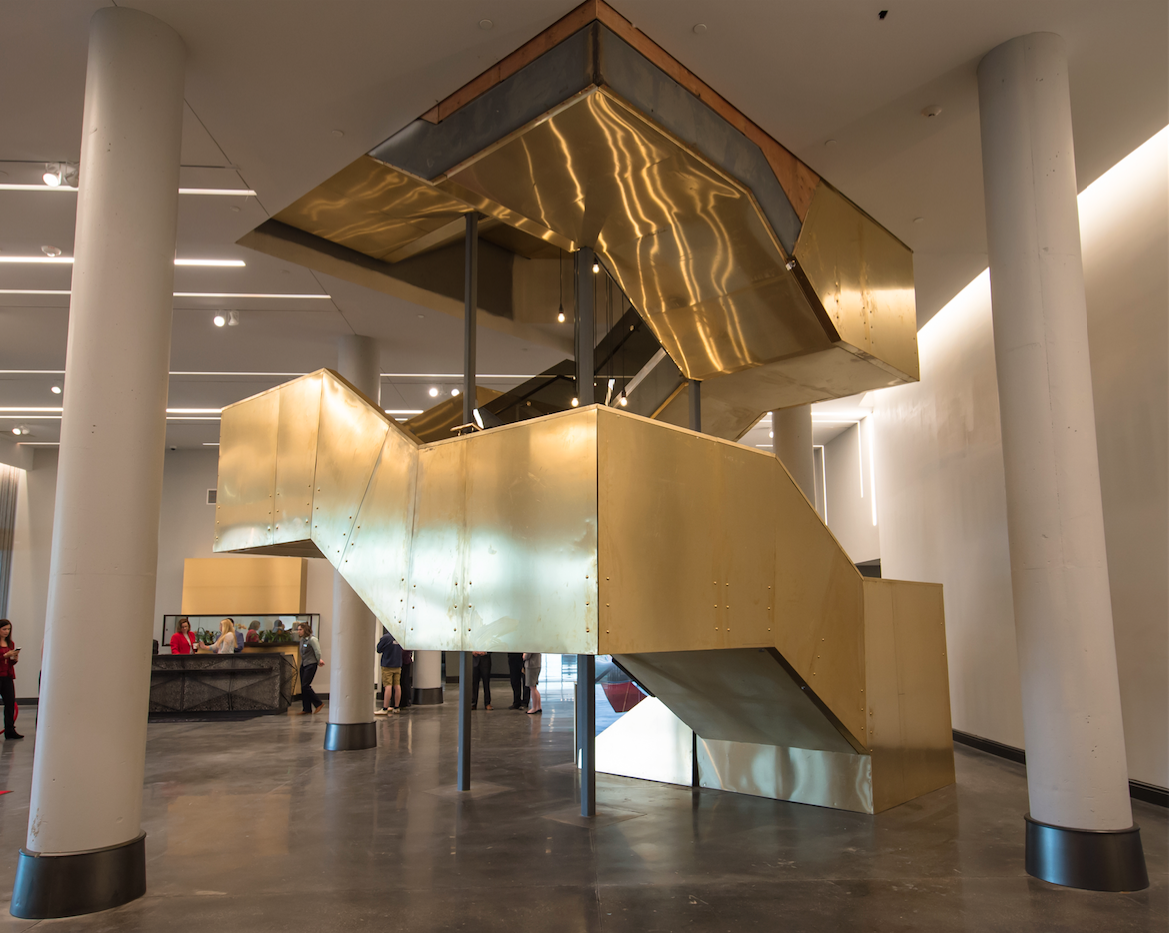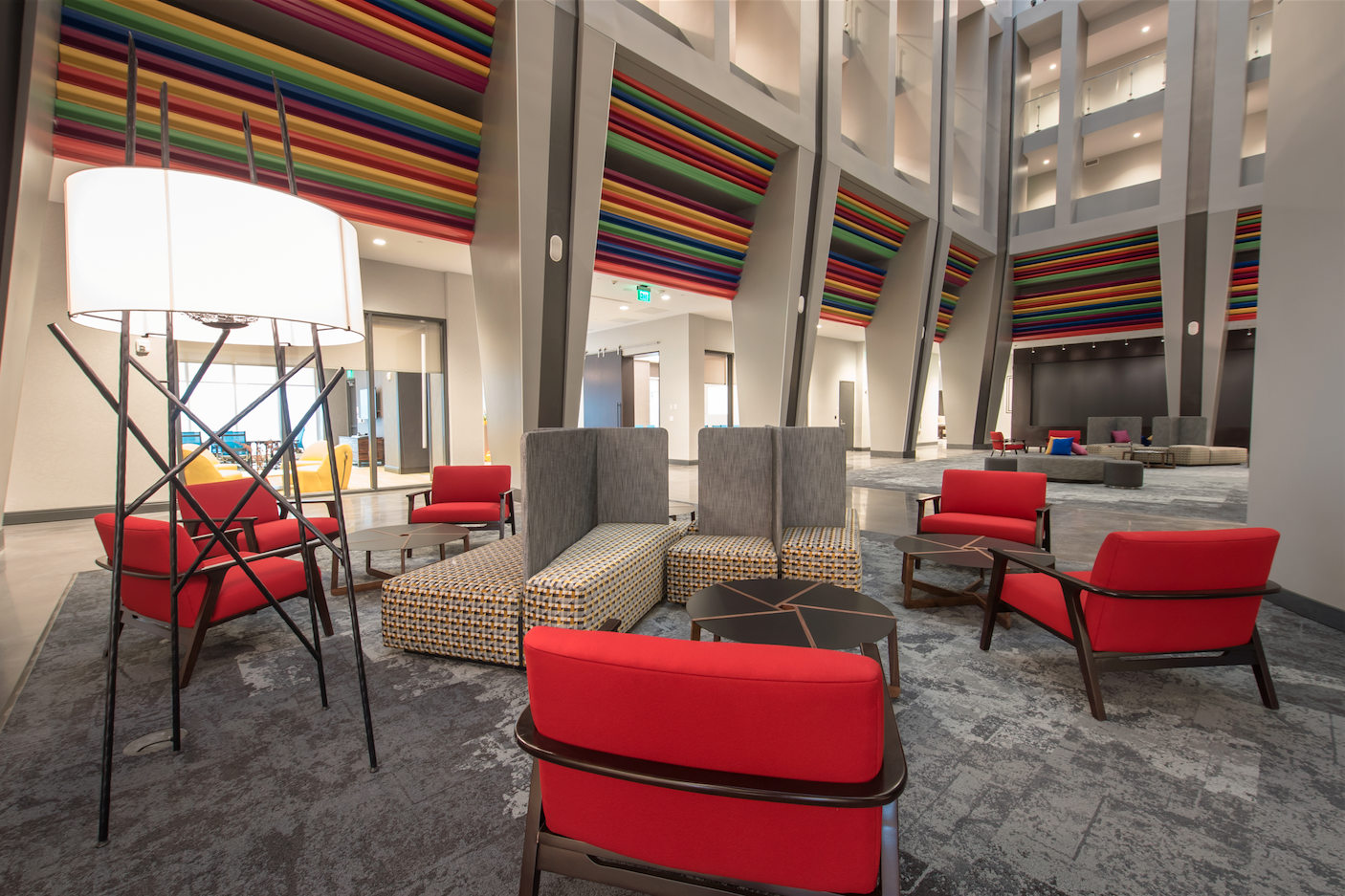It doesn’t look like much from the outside. But as they say, you can’t always judge a book by its cover.
And more interesting design flashes take over inside The Summit, A Dolce Hotel, featuring a 5,743-sf art gallery and an 11,600-sf rooftop terrace and garden space, which leads into a 4,750-sf ballroom that’s one of 19 meeting and banquet areas.
This 426,000-sf, 239-key lifestyle hotel and conference center, which opened adjacent to downtown Cincinnati on April 17, is the first hotel that Dolce Hotel and Resorts by Wyndham designed from scratch. On top of that, it’s an adaptive reuse of a parking garage that itself was once a warehouse-distribution facility.
“I think it is easily the top hotel/conference center combination in southwest Ohio,” says Chris Hopper, Executive Vice President and General Manager for Skanska Ohio, the project’s GC. RBM Development was the developer, Samach + Seo Architecture the design architect, CR Architecture & Design the AOR, and Hirsch Bednar Associates the interior designer.
Transforming a 50-plus-year-old structure into an $80 million hospitality venue, however, was not a foregone conclusion. The warehouse portion, once a NuTone factory, had been built in two stages, 1959 and 1976, and the city had no structural drawings for the 1959 work, which required the hotel’s Building Team to spend more than $100,000 on soil and load tests. Holes had to be drilled into the building’s columns to see how much steel they contained.
 The hotel’s restaurant, bar, and conference and meeting rooms are all located on its roof terrace, which includes 19 meeting spaces with 34,000 sf. Photo: Mike Howard Photography
The hotel’s restaurant, bar, and conference and meeting rooms are all located on its roof terrace, which includes 19 meeting spaces with 34,000 sf. Photo: Mike Howard Photography
Seth Barnhard, Principal and program manager for Sitement, the owner’s rep, says there were “prolonged discussions” about whether just to tear down the parking garage and build new. “It took months of VE [value engineering] to get the cost down to where [reconstruction] made sense.”
On the plus side, the existing building offered an 85,000-sf floorplate. And the parking garage had already been stripped of its cladding to the concrete, so the Building Team pretty much knew what it was working with.
The demolition part of this job took around four months, during which Skanska cut through the structure to create the hotel’s atrium space, which was probably the most important design decision on this project.
The nine-story atrium—a first for a Dolce-branded hotel—was one of three design options that Samach + Seo presented for this project, says Raphael Samach, AIA, Partner with the New York-based firm. The atrium was selected, he explains, because it allowed the structural loads to be redistributed while giving the hotel its greatest height.
Dolce is marketing The Summit as a “lifestyle” hotel, and Barnhard says its design is meant to convey an “ongoing sense of surprise” for guests who enter through a porte cochere that leads into an art-adorned lobby—whose grey palette is flecked with color accents—and portal to the atrium with four glass elevators.
 Photo: Mike Howard Photography
Photo: Mike Howard Photography
The terrace on the roof of the hotel’s 200-slot, two-level parking deck is programmed as a destination and “oasis” for guests and visitors, says Samach. The hotel’s restaurant, bar, conference and meeting rooms are all located on the roof. Servicing the meeting rooms are nourishment “hubs,” which offer a variety of snacks and refreshments during most of the day. (The hotel has two beehives on the roof to make its own honey, and this spring intended to plant its own herb garden.)
However, Skanska still needed to install micro piles in the basement to fortify the existing building that’s supported by an unusual mixture of spread piles and piers, says Jon Budde, Skanska’s project manager.
RMB is an acronym for Red Bank Madison, a development company owned by August Troendle, CEO and Founder of Medpace, a clinical research organization. Next to The Summit, Medpace just started construction on a 250,000-sf headquarters building. The entire complex, which sites on 30 acres, will include 250 multifamily residential units, a walking path, and possibly a Food Hall.
 Photo: Mike Howard Photography
Photo: Mike Howard Photography
 Photo: Mike Howard Photography
Photo: Mike Howard Photography
Related Stories
Education Facilities | Aug 4, 2024
A former supersonic wind tunnel becomes a new educational facility for transportation design
The Mullin Transportation Design Center at ArtCenter College of Design in Pasadena, Calif., provides access for full-scale vehicular models, replicating a professional design studio.
Adaptive Reuse | Jul 30, 2024
Empty mall to be converted to UCLA Research Park
UCLA recently acquired a former mall that it will convert into the UCLA Research Park that will house the California Institute for Immunology and Immunotherapy at UCLA and the UCLA Center for Quantum Science and Engineering, as well as programs across other disciplines. The 700,000-sf property, formerly the Westside Pavilion shopping mall, is two miles from the university’s main Westwood campus. Google, which previously leased part of the property, helped enable and support UCLA’s acquisition.
Great Solutions | Jul 23, 2024
41 Great Solutions for architects, engineers, and contractors
AI ChatBots, ambient computing, floating MRIs, low-carbon cement, sunshine on demand, next-generation top-down construction. These and 35 other innovations make up our 2024 Great Solutions Report, which highlights fresh ideas and innovations from leading architecture, engineering, and construction firms.
Adaptive Reuse | Jul 12, 2024
Detroit’s Michigan Central Station, centerpiece of innovation hub, opens
The recently opened Michigan Central Station in Detroit is the centerpiece of a 30-acre technology and cultural hub that will include development of urban transportation solutions. The six-year adaptive reuse project of the 640,000 sf historic station, created by the same architect as New York’s Grand Central Station, is the latest sign of a reinvigorating Detroit.
MFPRO+ News | Jun 24, 2024
‘Yes in God’s Backyard’ movement could create more affordable housing
The so-called “Yes in God’s Backyard” (YIGBY) movement, where houses of worship convert their properties to housing, could help alleviate the serious housing crisis affecting many communities around the country.
Multifamily Housing | Jun 14, 2024
AEC inspections are the key to financially viable office to residential adaptive reuse projects
About a year ago our industry was abuzz with an idea that seemed like a one-shot miracle cure for both the shockingly high rate of office vacancies and the worsening housing shortage. The seemingly simple idea of converting empty office buildings to multifamily residential seemed like an easy and elegant solution. However, in the intervening months we’ve seen only a handful of these conversions, despite near universal enthusiasm for the concept.
Adaptive Reuse | Jun 13, 2024
4 ways to transform old buildings into modern assets
As cities grow, their office inventories remain largely stagnant. Yet despite changes to the market—including the impact of hybrid work—opportunities still exist. Enter: “Midlife Metamorphosis.”
Adaptive Reuse | Jun 6, 2024
Latest phase of London redevelopment completes two new buildings
Developers are creating a neighborhood for 25,000 residents and workers.
MFPRO+ News | Jun 3, 2024
New York’s office to residential conversion program draws interest from 64 owners
New York City’s Office Conversion Accelerator Program has been contacted by the owners of 64 commercial buildings interested in converting their properties to residential use.
Adaptive Reuse | May 15, 2024
Modular adaptive reuse of parking structure grants future flexibility
The shift away from excessive parking requirements aligns with a broader movement, encouraging development of more sustainable and affordable housing.

















